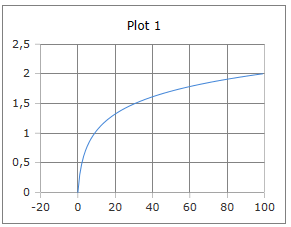Log, base 10 logarithm
Calculator and formula for the base 10 logarithm
Base-10 logarithm calculator
What is calculated?
The Log function returns the base 10 logarithm of the given number (power value). The argument must be a positive real number.
Function graph

Graph of the base-10 logarithm function log(x)
Base-10 logarithm info
Properties
Base-10 logarithm:
- Base: 10
- Domain: (0, ∞)
- Range: (-∞, ∞)
- Inverse function of 10^x
Note: The base-10 logarithm is defined only for positive numbers. For complex numbers a separate function is available.
Special values
Logarithm of 1 is always 0
Logarithm of the base is 1
log(10²) = 2
log(10⁻¹) = -1
Related functions
For complex numbers a separate Log function is available: → Complex base-10 logarithm
Formulas of the base-10 logarithm
Definition
Conversion with ln
Product rule
Power rule
Quotient rule
Derivative
Calculation example
Example: calculate log(100)
Given:
- x = 100
- Wanted: log(100)
Calculation:
Interpretation: 2 is the exponent to which base 10 must be raised to obtain 100.
Scientific notation
Example: determine orders of magnitude
Problem:
How many digits does the number 1,000,000 have? Determine the order of magnitude using the base-10 logarithm.
Solution:
The number has 7 digits (6+1)
Application: The base-10 logarithm is often used to determine orders of magnitude and in scientific notation.
pH value calculation
Practical example: pH value
Given:
Hydrogen ion concentration [H⁺] = 0.001 mol/L
pH value:
Result: The solution is acidic with pH = 3.
Definition and applications
Historical background
The base-10 logarithm (also called the Briggsian logarithm) was historically the first practical logarithm. It is also known as the common logarithm.
Practical applications
Base-10 logarithms are used in many areas: pH calculations, decibel scale, Richter scale, scientific notation, and wherever orders of magnitude matter.
Mathematical properties
- Domain: x > 0
- Range: all real numbers
- Monotonicity: strictly increasing
- Continuity: continuous on (0, ∞)
|
|